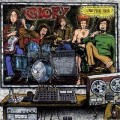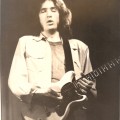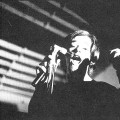(Ray Brandes reaches deep into the roots of San Diego’s underground to tell the tale of Jerry Raney and the early scene’s most enduring act. Excerpted from Getting Nowhere Fast, Ray’s definitive account of San Diego’s music underground from 1976 to 1986. )
1967-1978
 In a 1978 Village Voice editorial, music journalist Lester Bangs proclaimed: “The music business today still must be recognized as by definition an enemy, if not the most crucial enemy, of music and the people who try to perform it honestly.”
In a 1978 Village Voice editorial, music journalist Lester Bangs proclaimed: “The music business today still must be recognized as by definition an enemy, if not the most crucial enemy, of music and the people who try to perform it honestly.”
By the mid-’70s, multinational corporations had taken control of most of the industry, leaving independent record labels and local music scenes to fend for themselves. Longtime music fan and San Diego expatriate Harold Gee remembers the dismal state of affairs which would ultimately lead to the punk movement: “Everything, from the top down, from radio and all other media was total crap. The problem for me was the disconnect between the music that moved me, which mostly seemed to be either in the past or on jazz records, that only got played in a few people’s houses.”
Throughout the ‘70s, however, a few local underground acts had held firmly, David-like in their resistance to the corporate Goliaths. One such band was San Diego’s beloved hard-rock bad-asses Glory, who according to one critic, left “a big greasy mark (and a few stains) on Southern California’s rock & roll scene.”
 Glory’s main attractions were local guitar hero and future Beat Farmer Jerry Raney; second lead guitarist and keyboardist Jack Butler (rumored to have the longest hair in San Diego); flamboyant front man Mike Milsap; and original Iron Butterfly rhythm section Greg Willis and Jack Pinney.
Glory’s main attractions were local guitar hero and future Beat Farmer Jerry Raney; second lead guitarist and keyboardist Jack Butler (rumored to have the longest hair in San Diego); flamboyant front man Mike Milsap; and original Iron Butterfly rhythm section Greg Willis and Jack Pinney.
 For more than a decade, Glory flaunted their reputation as ne’er-do-well party boys who couldn’t keep a manager for more than a few months at a time. They were regulars at the infamous Balboa Park and La Jolla Cove Love-In concerts, and their rioting fans closed down free concerts at the Starlight Bowl on a number of occasions.
For more than a decade, Glory flaunted their reputation as ne’er-do-well party boys who couldn’t keep a manager for more than a few months at a time. They were regulars at the infamous Balboa Park and La Jolla Cove Love-In concerts, and their rioting fans closed down free concerts at the Starlight Bowl on a number of occasions.
 They were the first band to play San Diego Stadium and the first rock-’n’-roll group to play the Belly Up Tavern. And they opened for a number of major-label acts, including ZZ Top, Canned Heat, Howlin’ Wolf, Bo Diddley, The Electric Light Orchestra, Steely Dan and the James Gang.
They were the first band to play San Diego Stadium and the first rock-’n’-roll group to play the Belly Up Tavern. And they opened for a number of major-label acts, including ZZ Top, Canned Heat, Howlin’ Wolf, Bo Diddley, The Electric Light Orchestra, Steely Dan and the James Gang.
 Glory, however, never sold out. The band refused to clean up their act, preferring instead to always do things their own way. As guitarist Jerry Raney puts it, “We were just a bunch of rockers who really didn’t get the big picture.”
Glory, however, never sold out. The band refused to clean up their act, preferring instead to always do things their own way. As guitarist Jerry Raney puts it, “We were just a bunch of rockers who really didn’t get the big picture.”
Ain’t That a Shame?
The Glory story begins with the birth of Jerry Raney in 1951 in the small, dusty, desert town of El Centro in Imperial County, Calif., which shares a border with Mexico to the south and Arizona to the east. The Imperial Valley is farm country, irrigated by water that flows freely from the Colorado River. Thousands of Okies from Midwestern dustbowl farms had migrated to the area in the ‘30s and ‘40s, and by the mid-’50s, El Centro’s population was just under 15,000. Hotrods cruised Main Street, blasting the rock-’n’-roll hits of the day, while Mexican migrant workers walked through town, window-shopping the closed stores on Sundays. One of Jerry’s earliest memories is the sound of trucks in the town’s alleys, spraying DDT to combat the insect infestations produced by local farms.
Raney’s family was too poor to own a television, so while their neighbors kept company with the Kramdens and Ricardos, Fats Domino, Chuck Berry and Elvis Presley entered the Raney home in the evenings through the radio. Jerry recalls: “My teenage sisters would have little dance parties with their friends, and I would grease up my hair, try to look like Elvis and rock out with them until they tossed me out.” At eight years old, he joined the Fats Domino fan club at his school and danced to 45s with a dozen teenage girls. “Rock ‘n’ roll ruled my world,” he says.
In 1963, at 12 years of age, Raney and his family moved to El Cajon, a suburb east of San Diego that in many ways mirrored the small town, agricultural ambience of El Centro. Jerry’s mother was active in the tiny Jehovah’s Witness congregation in El Cajon, and before the school year began at Cajon Valley Junior High, he met Lester Bangs, son of another Kingdom Hall attendee.
Bangs, who would later gain fame as an influential music journalist, burned an indelible image into Jerry’s psyche. “Lester’s mom kept her house spotless until you stepped into his room,” Raney remembers. “There were two-week-old bowls of breakfast cereal on the floor and crap all over the place. You couldn’t even walk through it without stepping on something. He was the messiest guy I’d ever met.” While Jerry listened to his rock-’n’-roll records, Lester played his Charlie Mingus, Sonny Rollins and Miles Davis on a dilapidated turntable. The two shared musical influences with each other, but it was Bang’s attitude, however, which impressed Jerry the most.
“Lester wasn’t into sports and hated gym class,” Raney says. “Most of the time, he wouldn’t participate at all. The way to make up for the lost time was to write a report on sports, and you would get a point-a-page credit. He had missed a lot of class and showed up one day with something about the size of a book entitled ‘Hector the Homosexual Monkey’. He handed it in, and then he was gone.”
Another kindred spirit who became fast friends with Raney was Jack Butler, whose appearance was shocking by 1963 standards. “Jack Butler was one of the first people I met in El Cajon,” recalls Raney. “I remember thinking he looked like some street punk from England.”
In February of the following year, the Beatles arrived in New York City, and El Cajon, like every other town in America, was changed forever. For Jerry, it was an epiphany. “The Beatles just seemed to step in and completely take over the rock-‘n’-roll world,” he says. “They played on the Ed Sullivan show on Sunday night, and all anyone at school could talk about the next day was them. The guys that weren’t ‘rock ‘n’ roll’ didn’t like them, but the girls all loved them, and had already picked the ones they were going to marry. As for my friends and me, our lives had just changed big time.”
Raney began to grow out his hair, Beatles-style, and he and Butler began learning guitar together. “Butler’s dad was the gym coach at Greenfield Jr. High, and couldn’t stand my long hair,” Jerry says. “We’d be in his room playing guitar, and if his dad came home I’d have to leave. The funny thing about that is when Jack moved out of their house, he grew his hair longer than anyone I knew!”
Raney’s first guitar, a throwaway Japanese model, was traded in for a Fender Stratocaster and ultimately replaced by a Gibson ES335. In three months, Jerry had learned enough guitar to join a band. He met Phil Green, the leader of the Perennials, a dance band whose repertoire consisted of early ‘60s standards like “Louie, Louie”; “Money”; and “What’d I Say.” “Phil was a really good player,” remembers Jerry, “but pretty square.” Raney learned lead guitar basics from Green, and they started the Persuaders together, but “soon enough,” laughs Jerry, “I was kicked out for being ‘too English.’ “
Raney was now confident enough as a singer and lead guitarist to start his own band, The Jesters, with Bob Friedman on drums, Larry Tanner on bass, Steve Sherwood on sax and Chuck Surface on organ. “After about eight months, Larry quit, I dropped the sax player, talked Butler into playing bass, and Thee Dark Ages were born. We were finally cool!” Jack Butler remembers breaking up the band he was playing in at the time to join Raney’s new group. “Lester and I and two other friends shared a low-rent house next door to a Hell’s Angels clubhouse, where we could make lots of noise,” Butler says. “We were a four piece with me on lead guitar and Lester on harmonica. Jerry walked in and said he had booked a four-hour high-school dance gig in three days and needed a bass player. Then he asked me to be the bass player — not our bass player, which was odd and a bit awkward. Even though I really did not play bass, I immediately broke up the band and went out and bought a bass.”
To read the rest of Glory’s story, purchase Getting Nowhere Fast, Ray Brandes’ definitive account of San Diego’s music underground from 1976 to 1986.